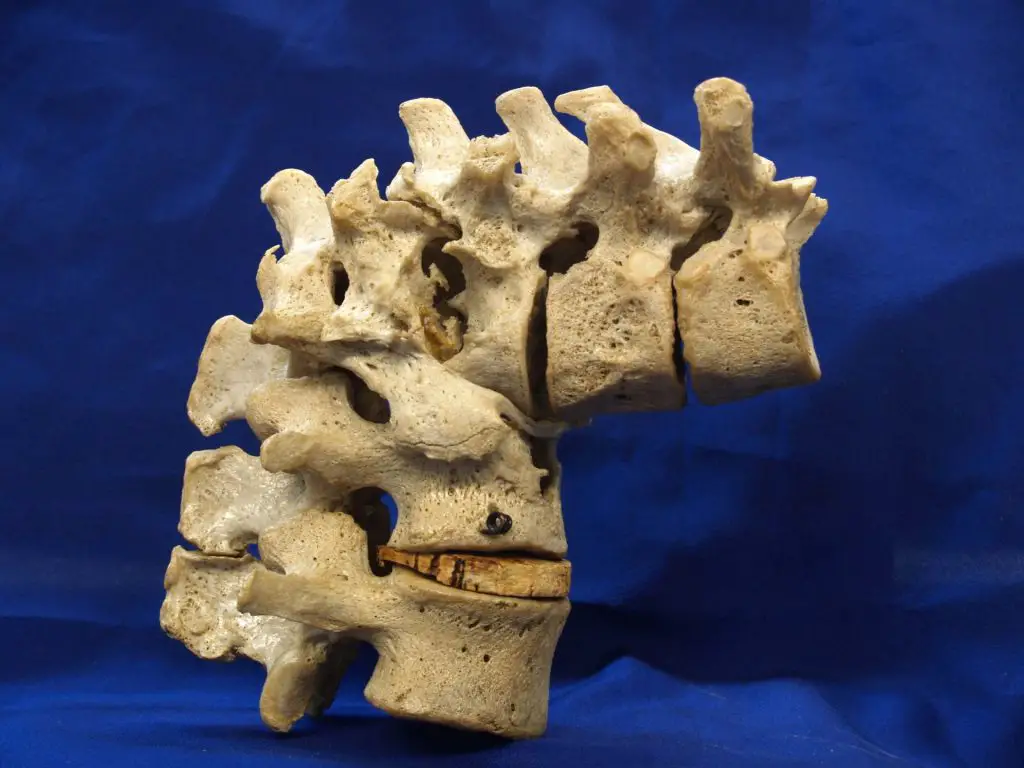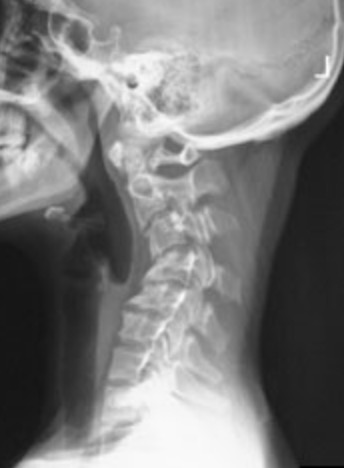Article reviewed and approved by Dr. Ibtissama Boukas, physician specializing in family medicine
Quasimodo, the hunchback of Notre-Dame, presented with exaggerated dorsal kyphosis. Maybe you also have an arched back, and want to know more about this peculiarity of the spine.
Is it serious, a dorsal kyphosis? Can this posture, often considered unsightly, be corrected, or at least prevented? Is it directly related to back pain?
This article tells you everything you need to know about dorsal kyphosis, with a focus on strategies to reduce it.
Definition and anatomy
Before talking about dorsal kyphosis (also called thoracic kyphosis), it is worth briefly recalling some key anatomical concepts related to the spine.
Spine anatomy
The spine (or vertebral column) is made up of 4 segments: The column cervical, dorsal (or thoracic), lumbar and sacred.
The spine presents natural curvatures when viewed in profile. This helps maintain body balance, as well as upright posture and ambulation.
Thus, the cervical and lumbar region has natural lordosis (C-shaped), and the dorsal column presents a kyphosis allowing in particular to leave room for the heart and the lungs (inverted C force).
It is therefore understood that dorsal kyphosis is not a pathological condition as such. It is only when the curvature becomes exaggerated that there is potentially a problem.
More specifically, the dorsal column presents an angle between 20 and 45 degrees in the majority of individuals. This is considered “normal”. If the curvature has an angle outside this range (more than 50 degrees), then it is called hyperkyphosis.
It is possible to carry out tests ofmedical imaging such as an X-ray to quantify the angle of the dorsal kyphosis, and determine if it affects related structures).
Moreover, a prominent dorsal kyphosis can be found in anyone, although it often affects adolescents and the elderly.
Difference with scoliosis
While kyphosis refers to a hunched back, scoliosis is a deviation of the spine in all 3 planes of space. Basically, one or more vertebrae are deviated in the frontal, sagittal, and horizontal plane. Vertebral rotation (torsion) in the horizontal plane is what mainly characterizes scoliosis.
The potential causes of scoliosis and kyphosis are different, as are their management. To learn more about scoliosis, see the following article.
Difference with lordosis
Like kyphosis, lordosis is a normal curvature of the spine. We speak of posterior concavity in medicine. Here, it should be specified that the curvature is located in the cervical and lumbar areas. Each person therefore has a cervical lordosis and a lumbar lordosis.
You should know that the reasons for theaccentuation of lordosis are varied. In the dock, we distinguish:
- a physical malformation
- the adoption of unsuitable and prolonged postures
- obesity
- the pregnancy
- certain sports practices (gymnastics)
- excessive wearing of high heels
We will speak of pathology in the case where the curvature is accentuated in an exaggerated way. In such conditions, lordosis is called hyperlordosis. This deformation promotes more or less serious consequences in patients.
Hyperlordosis can lead to lower back pain or lower back pain. However, in many cases, lordosis or hyperlordosis is not painful (asymptomatic hyperlordosis).
Now, what is the difference between kyphosis and lordosis?
The position
It is true that kyphosis and lordosis are curvatures in the spine, but they are in different regions. Dorsal kyphosis lies between cervical lordosis and lumbar lordosis. The first at your upper back and the second at your lower back.
Because of this, the dorsal kyphosis is in the middle of the back. Thoracic kyphosis takes into account 12 vertebrae. Cervical lordosis and lumbar lordosis include 5 and 7 vertebrae respectively.
The type of curvature
When you look at the spine from the front, it looks straight. However, observed in profile, one notices a succession of curves from the neck to the buttocks.
Cervical lordosis and lumbar lordosis form inward bends at either end of the dorsal kyphosis. The latter is characterized by a longer outward curvature.
The pathology
Hyperkyphosis can end up creating a hump in the back. Hyperlordosis accentuates the curvature of the hollow of the kidneys. In the long term, it is possible that these deformities cause spinal disorders. In particular, the following conditions are considered:
- Herniated disc
- Dorsal hernia
- Lumbar osteoarthritis
- Cervical arthritis
- Degenerative disc disease
- etc.
Fortunately, these spinal deformities can be taken care of.
Is it serious, a dorsal kyphosis?
In the vast majority of cases, dorsal kyphosis is asymptomatic, that is, it does not cause symptoms. This may be due to the fact that the dorsal kyphosis is of postural origin, and can therefore easily be corrected by straightening his back.
Even when the dorsal kyphosis is exaggerated, it may not cause any problems. This comes from the fact that the body has been able to adapt over time, and that the deformation of the spine does not lead to nervous or respiratory consequences.
In which cases can we then consider a dorsal kyphosis as being problematic?
- When associated with an underlying pathology (ankylosing spondylitis, Scheuermann's disease, osteoporosis, etc.)
- When it causes back pain or between the shoulder blades
- When it causes osteoarthritis or discopathy (such as intra spongy hernia)
- When it causes numbness in the arms or legs, or if the pain radiates to the lower limbs or higher
- When it affects the breathing
- When it comes from a tumor
- When it causes an aesthetic disorder in the patient (self-esteem)
Breathing difficulties related to kyphosis
In more serious cases, the kyphosis can lead to compression of the lungs by the ribs, making the breathing difficult.
The deformity can thus reduce the space available for the lungs inside the rib cage, limiting their ability to fully expand during inspiration.
This compression of the lungs can lead to decreased lung function, which means less oxygen is taken in and less carbon dioxide is expelled.
Additionally, kyphosis can affect muscles used for breathing, such as the diaphragm and intercostal muscles. These muscles can become fatigued more quickly, which can lead to shortness of breath even during light activities.
Additionally, inefficient breathing can also impact the cardiovascular system, as the heart has to work harder to oxygenate the body.
Finally, insufficient lung ventilation can increase the risk of respiratory infections such as pneumonia.
Although there are treatments available to alleviate some of the symptoms, the exaggerated kyphosis can be a lifelong condition that has a significant impact on quality of life.
How to sleep with dorsal kyphosis ?
Many patients want sleep advice when they have prominent dorsal kyphosis.
To answer this question, we must understand that it is impossible to maintain the same position throughout the night. It is therefore useless to prescribe a particular posture aimed at correcting the dorsal kyphosis.
If you sleep on your back most of the time, it is recommended to gradually reduce the height of your pillow. This will reduce the cervical protraction often associated with dorsal kyphosis, and thereby correct your round back.
If you sleep on your side, avoid as much as possible the position of the fetus which accentuates the dorsal kyphosis.
Sleeping on your stomach naturally reduces dorsal kyphosis, but can put more stress on the cervical vertebrae. Make sure you don't develop any neck problems if you choose this position.
Using a suitable pillow: which pillow to choose?
People with kyphosis often suffer from back pain, headaches and sleeping troubles. One way to relieve these symptoms is to use a pillow that supports the neck and keeps the spine in alignment.
There are a few things to keep in mind when choosing a pillow for kyphosis:
- First, the pillow should be firm enough to provide support, but not so firm as to cause discomfort.
- Next, the pillow should be high enough to support the head and neck, but not so high as to create tension in the shoulders.
- Finally, the pillow should be large enough to fill the space between the shoulder blades, but not so large that it interferes with sleep.
With a bit of trial and error, people with kyphosis can find a pillow that helps them sleep better and relieve their symptoms.
To know the benefits oforthopedic pillow shape memory, see the following article.
What about the mattress? Should I choose an appropriate mattress?
An important step is to choose the right mattress. A mattress that is too soft will not bring a adequate support for the spine, while a mattress that is too firm will put unnecessary pressure on the back.
For people with kyphosis, the ideal mattress is a medium-firm mattress, which provides enough support to keep the spine aligned while being padded enough to reduce pressure points.
Side, stomach or back sleepers all have different needs when it comes to mattress firmness and support. If you suffer from kyphosis, take the time to find the right mattress can make a big difference in your quality of life.
How to correct a dorsal kyphosis?
Here are some possible solutions to reduce exaggerated dorsal kyphosis:
Observation
Sometimes no treatment will be prescribed to correct the dorsal kyphosis. This occurs when it is believed that the child with this condition will naturally correct his posture after adolescence.
One can also prescribe point X-rays to follow the evolution over time, and to ensure that the dorsal kyphosis remains within normal limits (especially in the presence of scoliosis).
Mobility exercises
Exercises to open the thoracic cage associated with extension of the spine often make it possible to mobilize the dorsal vertebrae. This allows in the long run to reduce the dorsal kyphosis.
Here are some examples of exercises often given in physiotherapy (physiotherapy):
Back extension
- Sit down with your head and back straight.
- Grab the back of your neck with your hands, keeping your elbows pointing forward (as shown).
- In the same movement, bring the elbows up, the back extended and the head backwards.
- Slowly return to the initial position.
- Repeat ten times, taking breaks as needed.
For other solutions to straighten your back, see the following article.
Scapular retraction
- Sit down with your head and back straight. Bring your arms forward.
- In the same movement, bring the arms and shoulders back, squeezing the shoulder blades for 3 seconds.
- Return to the initial position.
- Repeat ten times, taking breaks as needed.
- Progression: Add resistance using a therapeutic rubber band.
breathing exercises
Breathing exercises allow the opening of the rib cage and the oxygenation of the lungs. This can indirectly help to correct the consequences of an exaggerated dorsal kyphosis.
Here is an example of a breathing exercise:
3-stroke breathing
- Lie on your back (ideally in an environment conducive to relaxation!)
- Inhale through your nose, expanding your stomach like a balloon. Without exhaling, extend your rib cage
- laterally. If you still have some breath left, end the inhalation by lifting your sternum.
- Then slowly exhale in the reverse order (lower the sternum, narrow the rib cage laterally and deflate the stomach).
- You can add light weight to your belly to increase resistance.
- Repeat ten times, going slowly.
Sport
Certain sports will favor the extension of the column, and will be preferred to reduce dorsal kyphosis. Among other things, we are thinking of:
- Swimming (backstroke)
- Ballet
- Gymnastics
- Running (with proper technique)
- etc..
On the contrary, certain sports can accentuate the dorsal kyphosis. Without necessarily stopping them, one can for example compensate by extension exercises after the sessions (like those demonstrated above). Here are the sports in question:
- Rugby
- Boxing
- Rowing
- Bikes
- etc..
Yoga
Because it encourages spinal mobility and incorporates breathing exercises, yoga has the potential to improve exaggerated dorsal kyphosis.
Obviously, it should be done gradually, and avoid movements that cause unusual symptoms. A yoga professional is best suited to guide you in this practice.
Corset
In some cases, a doctor will prefer to prescribe a corset aimed at correcting the dorsal kyphosis.
This may be the case in an adolescent suffering from scoliosis, and in whom we want to avoid the progression of his condition. The same goes for Scheuermann's disease.
The degree of correction, as well as the length of time the corset will be worn, depends on the patient's condition. In general, the use of the brace is reduced as the condition improves and the child finishes growing.
Some people choose to wear a lumbar belt to stabilize the trunk and promote a more upright posture. To know the opinion of a health professional on these belts, see the following article.
posture correctors
Office work and a sedentary lifestyle come with their share of consequences. These include slouched posture and increased dorsal kyphosis.
With this in mind, the posture correctors are often offered to "improve posture" and correct dorsal kyphosis.
Admittedly, it is sometimes relevant to benefit from external support to modify one's posture. On the other hand, you should know that the slouched posture is not directly related to back pain.
Also, a posture corrector is a passive strategy where the muscles are not active, and the freedom of movement of the spine is restricted. It is to this extent that posture correctors should be used in particular situations, and for a limited time.
To learn more, read this comprehensive opinion from a healthcare professional on posture correctors.
surgery
Surgery is prescribed in extreme cases. It aims to correct the dorsal curvature when it causes significant pain, irritates the adjacent nerve roots, or significantly restricts breathing.
It is also prescribed when the exaggerated dorsal kyphosis is congenital, or when it exceeds 75 degrees.
In general, it is prescribed as a last resort, that is to say after trying conservative approaches such as physiotherapy (physiotherapy), wearing a corset, etc.
Lumbar arthrodesis is often performed to correct pathological dorsal kyphosis. It will aim to improve posture, reduce pain, and prevent the aggravation of a disease (scoliosis, Scheuermann's disease, etc.).
In cases where the dorsal kyphosis is from a tumor, surgery is used to remove the tumor (especially if it is cancerous and/or there is concern about compression of the spinal cord).
Conclusion
Dorsal kyphosis is a normal anatomic feature of the spine.
It is only when it exceeds the normal range and/or causes secondary problems that it is considered pathological.
If so, there are several treatment approaches aimed at reducing dorsal kyphosis and improving posture.
In extreme cases, surgery can correct exaggerated dorsal kyphosis.
Good recovery !




